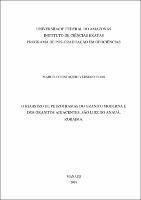| ???jsp.display-item.social.title??? |


|
Please use this identifier to cite or link to this item:
https://tede.ufam.edu.br/handle/tede/7330| ???metadata.dc.type???: | Dissertação |
| Title: | O registro de petrotramas do granito moderna e dos granitos adjacentes, São Luiz do Anauá, Roraima |
| Other Titles: | Petro-fabric pattern of the moderna granite and country rocks, southeastern Roraima, Amazon Craton, Brazil |
| ???metadata.dc.creator???: | Elias, Marcelo Eustaquio Versiani  |
| ???metadata.dc.contributor.advisor1???: | Salazar, Carlos Alejandro |
| ???metadata.dc.contributor.referee1???: | Nascimento, Rielva Solimairy Campelo do |
| ???metadata.dc.contributor.referee2???: | Almeida, Marcelo Esteves |
| ???metadata.dc.description.resumo???: | Diversos corpos graníticos Paleoproterozoicos do tipo-A intrudem o escudo das Guianas no Cráton Amazônico, dentre eles, o Granito Moderna (1.81 Ga), localizado entre a sede do município de São Luiz do Anauá e a Vila Moderna, no sudeste do estado de Roraima. Análises de anisotropia de susceptibilidade magnética (ASM, IRM e termomagnéticas), combinadas com dados estruturais de campo e dados petrográficos com enfoque microestrutural, foram realizadas a fim de se identificar o campo de esforços atuante, durante a colocação do Granito Moderna, correlaciona-lo à tectônica regional e à colocação de plutons graníticos do tipo-A Orosirianos na região. O Granito Moderna varia de monzogranito a sienogranito e está alojado em estrutura de direção NE-SW, na zona de contato entre os granitoides Martins Pereira (1,96-1,97 Ga) e Caroebe (1,89-1,90 Ga). O processo de cristalização plutônica compreende fluxo magmático com deformação plástica associada a alteração hidrotermal. Estruturas primárias semelhantes às observadas no Granito Moderna são presentes no Granito Caroebe, enquanto que o Granito Martins Pereira encontra-se predominantemente deformado em estado sólido. A deformação primária registrada nos granitos Moderna e Caroebe, apresenta direção principal ENE-WSW, com mergulho subvertical. As pontuais variações devem-se a zonas de cisalhamento NW-SE. As rochas analisadas apresentam orientação de foliações magmática e magnética concordantes, as quais refletem o campo de esforços, com encurtamento NW-SE, atuante no instante do alojamento crustal. |
| Abstract: | Several Paleoproterozoic A-type granite bodies intrude the Guiana shield in the Amazonian craton, among them, Moderna granite (1.81 Ga), located between São Luiz do Anauá city and Moderna village, in the southeast of Roraima state. Magnetic anisotropy analyzes (AMS, IRM and thermomagnetic) combined with field and microstructural focus petrographic data, were used to identify the field of stresses during the Moderna granite emplacement and correlate it with regional tectonics. The monzogranite with variations for syenogranite Moderna, presents NW-SE elongation in the contact zone between the calc-alkaline Martins Pereira (1.96 Ga) and Caroebe (1.89 Ga) granites, in transitional contact with these units, marked by hydrothermal alteration features, which do not affect the orientation of the rock's magmatic fabric and is responsible for its characteristic red color, associated with plastic deformation. The magnetic fabric, marked by magnetite, and magmatic fabric orientations of the three analyzed rock units have genetic equivalence and main direction around the E-W to NE-SW axis, in agreement with the regional structural framework that controls the Orosirian plutons emplacement in the central portion of the Guiana shield. Although there is a great difference in age, reported in the literature, between the crystallization of the granite units analyzed, these rocks developed minerals fabrics with similar orientation and strain mechanisms, indicating that the granite emplacements occurred syn-kinematicly under a dextral transpressive tectonic regime with plastic strain. Localized shear zones, sub-parallel to magmatic foliation orientation, demonstrate the persistence of the effort field at the end of the plutonic housing, while discrete posterior shear zones, NW-SE direction, deform restricted portions of the rock units in solid state. |
| Keywords: | Granito - Amazônia Crátons - Amazônia |
| ???metadata.dc.subject.cnpq???: | CIÊNCIAS EXATAS E DA TERRA: GEOCIÊNCIAS |
| ???metadata.dc.subject.user???: | Cráton amazônico Escudo das Guianas Domínio Uatumã-Anauá Granito moderna Petrotramas graníticas Alojamento plutônico Anisotropia de Susceptibilidade Magnética ASM |
| Language: | por |
| ???metadata.dc.publisher.country???: | Brasil |
| Publisher: | Universidade Federal do Amazonas |
| ???metadata.dc.publisher.initials???: | UFAM |
| ???metadata.dc.publisher.department???: | Instituto de Ciências Exatas |
| ???metadata.dc.publisher.program???: | Programa de Pós-graduação em Geociências |
| Citation: | ELIAS, Marcelo Eustaquio Versiani. O registro de petrotramas do granito moderna e dos granitos adjacentes, São Luiz do Anauá, Roraima. 2018. 73 f. Dissertação (Mestrado em Geociências) - Universidade Federal do Amazonas, Manaus, 2018. |
| ???metadata.dc.rights???: | Acesso Aberto |
| URI: | https://tede.ufam.edu.br/handle/tede/7330 |
| Issue Date: | 23-Nov-2018 |
| Appears in Collections: | Mestrado em Geociências |
Files in This Item:
| File | Description | Size | Format | |
|---|---|---|---|---|
| Dissetação_MarceloElias_PPGEOC.pdf | 3.48 MB | Adobe PDF |  Download/Open Preview |
Items in DSpace are protected by copyright, with all rights reserved, unless otherwise indicated.




